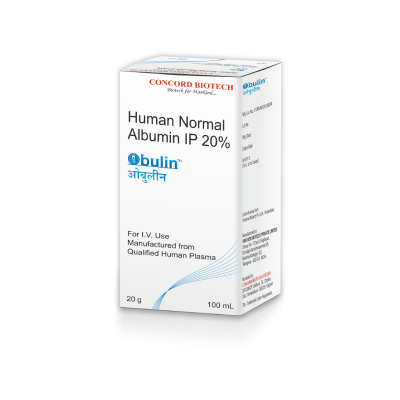
Plasma Products
Human Normal Albumin
- Brand logo & Packshot - Obulin™ 20%.
- Composition - Each vial contains Total Protein 200 g/Lit, Sodium Caprylate 6.65 g/Lit, Na+ ≤ 160 mmol/Lit, K+ ≤ 2 mmol/Lit, Aluminium ≤ 200 µg/Lit.
- Description - Human Normal Albumin IP 20% solution is a sterile, non-pyrogenic preparation of human albumin in a single dose container for intravenous administration. Albumin is a highly soluble, globular protein (molecular weight 66,500), accounting for 70-80% of the colloid osmotic pressure of plasma. Therefore, albumin is important in regulating the osmotic pressure of plasma. Human Normal Albumin 20% solution will increase the circulating plasma volume. This extra fluid reduces haemoconcentration and decreases blood viscosity. Each 100 ml contains 20 g of albumin and is prepared from qualified human plasma. The process includes several chromatographic steps and viral inactivation steps. The manufacturing process uses plasma collected from the donors who are screened for their history as per guidelines laid down by the regulatory authorities. Their blood is screened for the mandatory infectious diseases. Only on being declared negative to HbsAg, HCV and HIV I & II antibodies, the plasma is used for processing.
- Indications & Usage - Albumin is indicated in the treatment of hypovolaemic shock associated with blood loss, trauma and surgical procedures. Hypoalbuminemia is another possible indication which can result from Inadequate production (malnutrition, burns, major injury, infections, etc.), Excessive catabolism (burns, major injury, pancreatitis, etc.), Loss from the body (hemorrhage, excessive renal excretion, burn exudates, etc.) Redistribution within the body (major surgery, various inflammatory conditions, etc.). It could also be indicated in Hemolytic Disease of the Newborn, Plasma exchange /dialysis.
- Dosage & administration - In adults, an initial infusion of 100 ml is suggested. Additional amounts may be administered as clinically indicated. The initial dosage in children will vary with the clinical state and body weight. A dose one-quarter to one-half the adult dose may be administered or dosage may be calculated on the basis of 1-3 ml per kg body weight. For infants suffering from hemolytic disease of the newborn, the appropriate dose for binding of free serum bilirubin to albumin is 1 g per kg of body weight. This may be administered before or during the exchange procedures. In the treatment of the patient in shock with greatly reduced blood volume, it may be administered as rapidly as necessary in order to improve the clinical condition and restore normal blood volume. This may be repeated in 15-30 minutes if the initial dose fails to prove adequate. In the patient with a slightly low or normal blood volume, the rate of administration should be 1 ml per minute. The usual rate of administration in children should be one-quarter the adult rate.
- Storage conditions - Store between 2°C-25°C. Do not freeze. Protect from light.